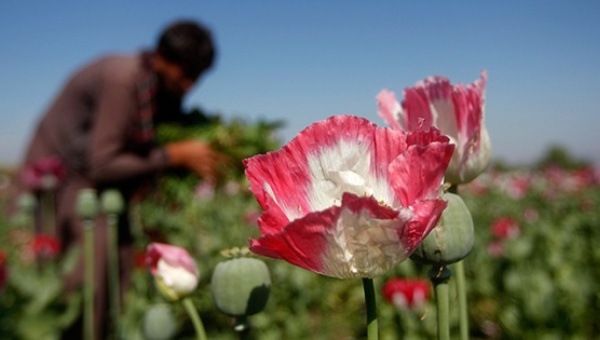Afghan Opium Production 40 Times Higher since US-NATO Invasion
ASIA--PACIFIC, 5 Sep 2016
teleSUR – TRANSCEND Media Service
About 90 percent of the world’s illegal opium is estimated to come from Afghanistan.
31 Aug 2016 – Since the U.S.-led NATO invasion of Afghanistan in 2001, the production of opium in the country has increased by 40 times according to Russia’s Federal Drug Control Service, or FSKN, fueling organized crime and widespread death.
RELATED: US ‘Owns’ Afghanistan: Ex-President Hamid Karzai
The head of the FSKN, Viktor Ivanov, explained the staggering trend at a March U.N. conference on drugs in Afghanistan. Opium growth in Afghanistan increased 18 percent from 131, 000 hectares to 154, 000, according to Ivanov’s estimates.
“Afghan heroin has killed more than one million people worldwide since the ‘Operation Enduring Freedom’ began and over a trillion dollars has been invested into transnational organized crime from drug sales,” said Ivanov according to Counter Current News.
WATCH: Bolivian Government Seizes Tons of Cocaine Headed to the U.S.
httpv://www.youtube.com/watch?v=J04E0SisMsQ
Prior to the invasion of Afghanistan, opium production was banned by the Taliban, although it still managed to exist. The U.S. and its allies have been accused of encouraging and aiding in the opium production and the ongoing drug trafficking within the region. Ivanov claimed that only around 1 percent of the total opium yield in Afghanistan was destroyed and that the “international community has failed to curb heroin production in Afghanistan since the start of NATO’s operation.”
RELATED: Former Afghan President Says US Airstrikes More Harm Than Good
Afghanistan is thought to produce more than 90 percent of the world’s supply of opium, which is then used to make heroin and other dangerous drugs that are shipped in large quantities all over the world. Opium production provides many Afghan communities with an income, in an otherwise impoverished and war-torn country. The opium trade contributed around $US2.3 billion or around 19 percent of Afghanistan’s GDP in 2009 according to the U.N.
Around 43 percent of drugs produced in Afghanistan are moved through Pakistan, according to the United Nations Office on Drugs and Crime.
The Islamic State Group is reported to have recently taken over opium production and trafficking. In November, the extremist group was estimated to be earning over $US 1 billion from the opium trade. Profits also go to international drug cartels and money-laundering banks.
Go to Original – telesurtv.net
DISCLAIMER: The statements, views and opinions expressed in pieces republished here are solely those of the authors and do not necessarily represent those of TMS. In accordance with title 17 U.S.C. section 107, this material is distributed without profit to those who have expressed a prior interest in receiving the included information for research and educational purposes. TMS has no affiliation whatsoever with the originator of this article nor is TMS endorsed or sponsored by the originator. “GO TO ORIGINAL” links are provided as a convenience to our readers and allow for verification of authenticity. However, as originating pages are often updated by their originating host sites, the versions posted may not match the versions our readers view when clicking the “GO TO ORIGINAL” links. This site contains copyrighted material the use of which has not always been specifically authorized by the copyright owner. We are making such material available in our efforts to advance understanding of environmental, political, human rights, economic, democracy, scientific, and social justice issues, etc. We believe this constitutes a ‘fair use’ of any such copyrighted material as provided for in section 107 of the US Copyright Law. In accordance with Title 17 U.S.C. Section 107, the material on this site is distributed without profit to those who have expressed a prior interest in receiving the included information for research and educational purposes. For more information go to: http://www.law.cornell.edu/uscode/17/107.shtml. If you wish to use copyrighted material from this site for purposes of your own that go beyond ‘fair use’, you must obtain permission from the copyright owner.
